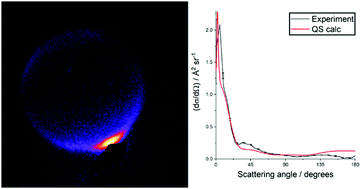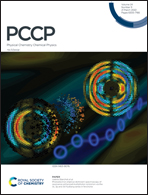Stereodynamics of rotational energy transfer in NO(A2Σ+) + Kr collisions
Abstract
A crossed molecular beam, velocity-map ion imaging apparatus has been used to determine differential cross sections (DCSs) and angle-resolved rotational angular momentum alignment moments for the state-resolved rotationally inelastic scattering of NO(A2Σ+, v = 0, j = 0.5 f1) with Kr at an average collision energy of 785 cm−1. The experimental results are compared to close-coupled quantum scattering (QS) calculations performed on a literature ab initio potential energy surface (J. Kłos et al., J. Chem. Phys., 2008, 129, 244303). DCSs are very strongly forward scattered, with weaker side and backward scattered peaks becoming progressively more important at higher-N′. Good agreement is found between experimental and QS DCSs, indicating that the PES is an accurate reflection of the NO(A)–Kr interaction energies. Partial wave analysis of the QS DCSs isolates multiple scattering mechanisms contributing to the DCSs, including L-type rainbows and Fraunhofer diffraction. Measured alignment moments are not well described by a hard-shell kinematic apse scattering model, showing deviations in the forward scattering hemisphere that are in agreement with QS calculations and arise from attractive regions of the PES. These discrepancies emphasise that established scattering mechanisms for molecules such as NO with lighter noble gases cannot be extrapolated safely to heavier, more polarisable members of the series.

- This article is part of the themed collection: 2022 PCCP HOT Articles


 Please wait while we load your content...
Please wait while we load your content...